Megan Dunn – 21 December, 2012
Robinson's new work trades in subtlety, starting with the obtuse title: Defunct Mnemonics. The title operates as an aural code, a key. That silent m in mnemonics, the word is hard to say, it gets muffled in the mouth. The title trips the tongue, the way the sticks trip the space, the viewer's mind and eyes back flipping on the repetition of scattered stripes.
Defunct Mnemonics was a gymnastic show, the viewer primed and ready for a conceptual work out. At Peter McLeavey gallery the floor resembled a gym lined with zany equipment in Doctor Seuss-esque socks and stripes. Weight training is built on repetition, on counting out the heft of heavy lifting. But in this case the stripey sculptures on display were impossibly light, some as long as javelins, others short and squat like dumb-bells. In strident red a pair of short sticks looked like double happys or dynamite. Each sculpture was handmade by Peter Robinson, based on a case of spirit sticks housed at Te Papa.
Robinson wrapped every stick in a roll of concentric felt. The activity was apparently addictive. Both process and product articulate the joy of repetition, whilst at the same time accentuating difference. Each stick is singular, yet plural. At the opening it was pleasurable to look around, searching for your favourite - the one you might buy - yet the gallery also felt like a forest or a fortress. Lined up around the space the sticks half conjured the walls of a pa.
So what is the metaphor at stake here? Are the spirits summoned from these sticks Robinson’s ancestors or are they just outmoded forms of production? Is the factory closed? The product the felt might once have been used for gone, or at least unseen, unknown, unappreciated. The skinniness of these sticks recalls Robinson’s aeroplanes which slid onto the art scene in the early 90’s challenging our reigning assumptions about cultural lineage and the limitations of whakapapa. Is the artist saying that the spirit stick is defunct? I don’t know. I’m wary of all this talk about art ‘saying’ anything, often I think art operates outside of communication, much art actually desires to tell us nothing, to be resolutely mute inside a world of howls and screams.
In the nineties identity art was so big and tourism of course continues to thrive on national signs that now appear sentimental and clichéd: the spiral shell, the Kiwi, the pohutakawa, the humble steel pukeko. Other symbols have faded from prominence: the soft toy Kiwifruit, its slack green jaw hanging open in a benevolent smile. And new talismans have been awakened: now in most tourist shops, a huddle of cuddly alpacas reside beside the sheepskin rugs.
In the arena of contemporary art Robinson has successfully rebelled and recoiled from this kind of cosy native pigeon holing. He’s always been adept at making the problem part of the subject. He became a significant artist very young, and this show proves yet again, that he is far from defunct. In his practice there is repetition, but also - centrally - change. I like the way he keeps moving around - the links in the chain of production show - but he’s not an artist content to freeze frame.
The presentation of Defunct Mnemonics reminds me of Parekowhai’s large pick up sticks, sitting in their shiny bundle, malevolent as knitting needles, too big for us to play with. But the effect here is softer, muffled. Robinson’s new work trades in subtlety, starting with the obtuse title: Defunct Mnemonics. The title operates as an aural code, a key. That silent m in mnemonics, the word is hard to say, it gets muffled in the mouth. The title trips the tongue, the way the sticks trip the space, the viewer’s mind and eyes back flipping on the repetition of scattered stripes.
I liked the way gallery goers jostled with the sculptures during the opening, standing skewered between each stick on the floor. A sequence of inadvertent art jousting unravelled as the wine was drunk. The space was animated by the installation. You stood in the middle of the art, you moved around the sticks like beavers running over a dam. Apparently Robinson had to mend one sculpture the next day. The intimacy of the dealer gallery setting allowed the display to be less cautious, more generous. The exhibition closed the physical gap between the viewer and the art, and somehow this was mirrored psychologically. Every time I returned to the show, I overheard someone in the back room buying a stick. I realise art as commodity is often contentious, especially within the realm of critique, but at it’s most basic level, a purchase mainfests either need or desire. In this case: desire.
Defunct Mnemonics is a nimble successor to Robinson’s last outing at Peter McLeavey. Polymer Monoliths was all about girth: the incredible hulk of polystyrene blocks, as chunky as Stonehenge, oblique in both mass and materials. The size of these sculptures seemed to defy explanation, stuffed into the gallery, larger than pink bats, they offered a form of pyschic insulation. But against what? We will never know. The materiality buffers the need for meaning. Defunct Mnemonics is equally nuanced in its juxtaposition of new and old worlds.
On my second visit to the exhibition Peter McLeavey was at the gallery. He asked me to pick up one of the sticks and hand it to him. I did. Peter talked about the relationship between religion and repetition, like counting out prayers when turning round rosary beads. He spoke about the history of Maori conversion to Christianity. We repeat to remember. A mnemonic is a learning technique to improve information retention. McLeavey also mentioned musical notations. Each felt coil, each stripe, like a piano key. A note. It was a welcome conversation. There I was with my gym training analogies, all my conceptual energies focused on the defunct, rather than the mnemonic.
Megan Dunn
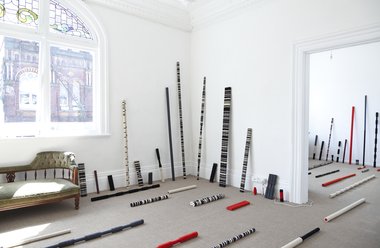
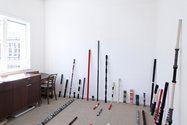
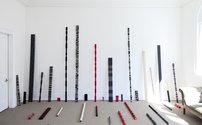
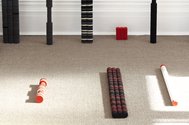
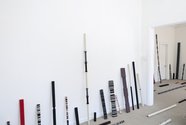
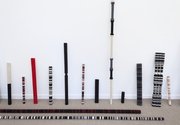
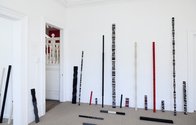
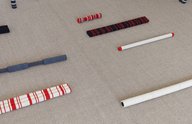
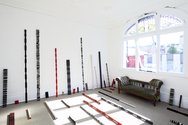

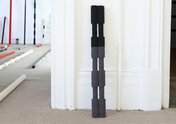
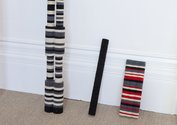

 Two Rooms presents a program of residencies and projects
Two Rooms presents a program of residencies and projects Advertising in this column
Advertising in this column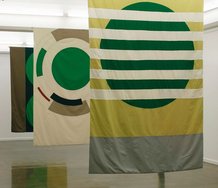
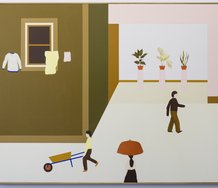
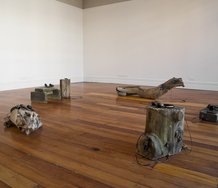
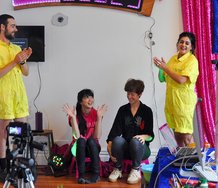
This Discussion has 0 comments.
Comment
Participate
Register to Participate.
Sign in
Sign in to an existing account.